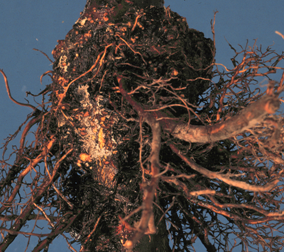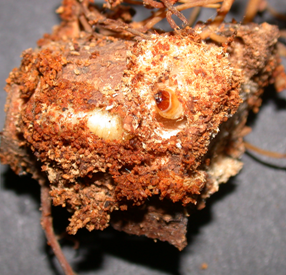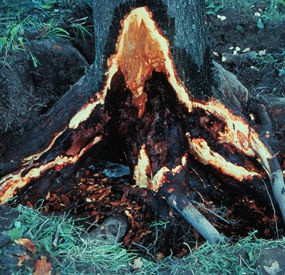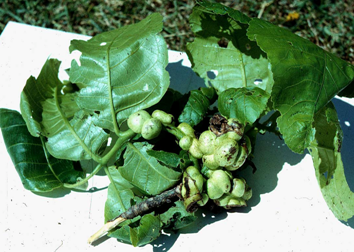What is a crown gall?

Crown gall is the most widely distributed bacterial disease of plants in the world, affecting over 100 species of fruit crops, and woody and herbaceous ornamentals, including rose, euonymus, lilac, poplar, viburnum, willow, apple, pear, brambles, stone fruits and grapes. Crown gall can cause severe damage on young plants, while mature woody plants with the disease may show no ill effects.
What does crown gall look like?
Crown gall gets its name from the round or irregularly shaped tumor-like growths (i.e., galls) that usually form on plant crowns just above or below the soil line. Galls can also form on roots, stems, trunks, or branches. Galls can be pea-sized, or as large as several inches in diameter. Galls interfere with water transport within the plant. Therefore, affected plants may suffer from water or nutrient deficiencies, becoming stunted. Flower and fruit production may also be reduced.
Where does crown gall come from?
Crown gall is caused primarily by the bacteria Agrobacterium tumefaciens, as well as (on grape) by A. vitis. Both bacteria survive in soil and in (or on) susceptible plant roots. The bacterium is spread through movement of contaminated soil, water and infected plant material. The bacterium enters plants through wounds (e.g., mechanical injuries including pruning cuts, freeze injury, and nematode feeding sites) or natural plant openings (e.g., lenticels) and stimulates plant cells to undergo unregulated growth, leading to gall formation. Once galls begin to form, they can continue to enlarge even if the bacterium is no longer present. Galls become visible anywhere from several weeks to one or more years after the time of infection.
How do I save a plant with crown gall?
There is no cure for crown gall once galls begin to form. Galls can be pruned away, but new galls may reform elsewhere on the plant. To prevent spread of the crown gall bacterium, remove infected plants, surrounding soil, and as many of the infected plant’s roots as possible.
How do I avoid problems with crown gall in the future?
Use disease-free, winter hardy stock from a reputable nursery and inspect the roots and crowns for galls before planting. Avoid wounding plants during transplant and cultivation. Decontaminate tools, equipment and shoes with 10% bleach or 70% alcohol for at least 30 seconds to prevent spread of the bacterium. Use of a biological control product can prevent A. tumefaciens infections at the time of planting. Current biological control products contain A. radiobacter, a close relative of the crown gall organism. These products are not effective on all hosts, or against all variants of the pathogen. In areas with infested soil, rotation to a non-susceptible plant (such as grass) for 3 years, may provide a good means of disease control. In commercial settings, soil fumigation may provide limited control of the crown gall bacterium in soil. However, fumigation does not kill the bacterium in roots that remain in the soil after removal of infected plants. Fumigation is not recommended for homeowners.
For more information on crown gall:
Contact the University of Wisconsin Plant Disease Diagnostics Clinic (PDDC) at (608) 262-2863 or pddc@wisc.edu.
Authors: Ann Joy and Brian Hudelson, UW-Madison Plant Pathology
Last Revised: 02/29/2024
D-number: D0035
References to pesticide products in this publication are for your convenience and are not an endorsement or criticism of one product over similar products. You are responsible for using pesticides according to the manufacturer’s current label directions. Follow directions exactly to protect the environment and people from pesticide exposure. Failure to do so violates the law.
Thanks to Diana Alfuth, Paul Hartman, and Patty McManus for reviewing this document.
A complete inventory of UW Plant Disease Facts is available at the University of Wisconsin-Madison Plant Disease Diagnostics Clinic website: https://pddc.wisc.edu.
Send a Plant Sample for Analysis
Be cautious when self-diagnosing plant health issues. Very few diseases can accurately be diagnosed by eye.
Contact the UW Plant Disease Diagnostics Clinic (PDDC), and for a small fee, clinic staff can examine a plant, determine the cause of the disease/disorder, and provide advice on how to control or prevent the issue.
Download Article





 Armillaria Root Disease
Armillaria Root Disease Pine Root Collar Weevil
Pine Root Collar Weevil Root and Crown Rots
Root and Crown Rots Deciduous Tree Galls
Deciduous Tree Galls


